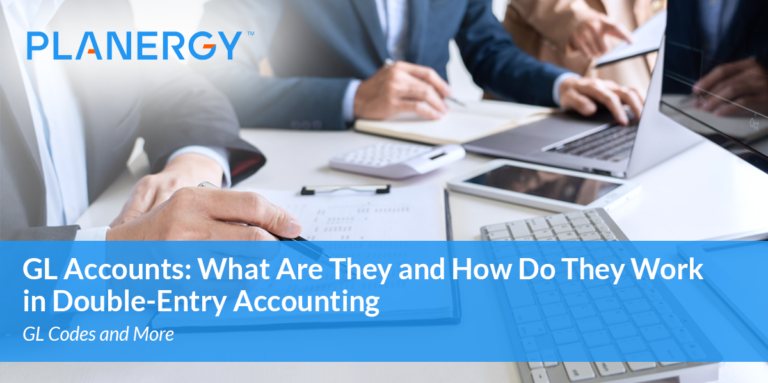GL accounts, or general ledgers, are essential to any business’ financial statements.
They are used to track various types of transactions and categorize them according to their impact on the bottom line.
For example, money spent on supplies, salaries, rent, and other operating costs would fall into different GL accounts depending on its purpose.
These accounts help organizations keep track of their expenses and revenue-generating activities to ensure that they are financially stable over time.
Although they may seem basic at first glance, GL accounts play an essential role in helping businesses manage their finances and maintain profitability.
Traditional accounting software allows you to connect your GL accounts to your bank accounts to keep up with account balances and financial transactions to simplify accounting processes.
General Ledger vs. Nominal Ledger
A general ledger account and a nominal ledger account are two distinct types of financial accounts used in most businesses.
The purpose of a general ledger account is to keep track of all the business’s assets, expenses, liabilities, and revenues.
In contrast, the purpose of a nominal ledger account is to identify any changes to specific types of expenses or revenues.
These accounts may also be used for things like analyzing trends over time, tracking expenses by department or location, and identifying opportunities for improvement.
In general, a nominal ledger account acts as a more specialized type of record-keeping within the larger system of the business’s general ledger accounts.
Of course, this is just an overview; many other intricacies distinguish these two accounts.
Ultimately, understanding their key differences can be helpful for anyone who manages finances in a business setting.
General Ledger vs. Subsidiary Ledger
A general ledger and a subsidiary ledger are two types of financial records that are typically used in business settings.
While the general ledger provides an overview of a company’s financial performance over a period of time, the subsidiary ledger is specifically focused on recording transactions related to individual accounts.
In other words, while the general ledger tracks overall revenue and expenditures, the subsidiary ledger helps to detail where exactly this money is coming from and going.
This can be particularly useful for businesses that want to closely monitor their cash flow and stay on top of their financial goals.
Types of GL Accounts
GL account types are used for tracking and categorizing different types of financial data within a company’s general ledger.
These types can include income, expenses, assets, liabilities, equity, and revenues.
Each type serves a specific purpose in providing detailed information about the financial health of a business.
Each GL account needs an account name to make it easier to follow and understand as transactions are recorded.
For example, income accounts track revenue earned from selling goods or services to customers, while expense accounts track spending on advertising or equipment maintenance.
Assets and liabilities help to show the current value of the company’s assets compared to its outstanding debts, providing crucial insights into whether it has a positive or negative net worth.
Overall, GL account types are essential tools for tracking business performance and making strategic decisions about how to grow and improve the company over time.
Assets
Assets are anything that a business owns and that has monetary value. This can include cash, investments, property, equipment, and inventory. Businesses need to keep track of their assets because they represent the resources a business has at its disposal.
Liabilities
Liabilities are anything that a business owes to another party. This can include money owed on loans, credit cards, or leases. Keeping track of liabilities is important because it helps businesses stay aware of how much money they owe and to whom they owe it.
Equity
Equity is the difference between a business’s assets and liabilities. In other words, it’s the portion of the business owned by the shareholders. Businesses use equity to finance their operations and expand their businesses.
Expenses
Expenses are the costs incurred by a business to operate. This can include rent, utilities, payroll, and advertising. Tracking expenses is important because it helps businesses budget their money and make informed decisions about where to allocate their resources.
General Ledger Codes and Example GL Code Structures
A General Ledger (GL) code is a code used to categorize financial transactions for reporting purposes.
Depending on the organization’s accounting needs, the GL code structure can be simple or complex.
Simple GL Code Structure
A simple GL code structure might look something like this:
- Assets: 1000-1999
- Liabilities: 2000-2999
- Equity: 3000-3999
- Income: 4000-4999
- Expenses: 5000-5999
This type of GL code structure is best suited for small businesses with simple accounting needs.
Complex GL Code Structure
A more complex GL code structure might look something like this:
- 1000-1099: Asset Accounts
- 1100-1199: Current Assets
- 1200-1299: Fixed Assets
- 1300-1399: Other Assets
- 2000-2099: Liability Accounts
- 2100-2199: Current Liabilities
- 2200-2299: Long-Term Liabilities
- 2300-2399: Other Liabilities
- 3000-3099: Equity Accounts
- 3100-3199: Common Stock
- 3200-3299: Paid-In Capital/Surplus/Retained Earnings
- 3300-3399: Other Equity
- 4000-4099; Income Accounts
- 4100-4199; Sales Revenues
- 4200-4299; Cost of Goods Sold
- 4300-4399; Other Income
- 4400-4499; Interest Income
- 5000-5099; Expense Accounts
- 5100-5199; Selling Expenses
- 5200-5299; General & Administrative Expenses
- 5300-5399; Other Operating Expenses
- 5400-5499; Depreciation & Amortization
- 5500-5599; Interest Expense
- 5600-5699; Taxes Paid
- 5700-5799; Extraordinary Items & Gains/(Losses)
- 5800-5899; Nonoperating Items & Gains/(Losses)
This type of GL code structure is best suited for large businesses with complex accounting needs.
As you can see, there are many ways to set up your GL codes. Finding a system that works best for your organization and your specific needs is key.
Appropriately categorizing transactions in your GL accounts can make things easier on your CPA and stakeholders.
How do debit and credit journal entries post to a GL Account?
Retaining accurate financial records is crucial for every business. One important aspect of maintaining this recordkeeping is using a general ledger, or GL, account.
A GL account represents all types of debits and credits that enter a company’s accounting system.
When a debit is entered into an account, it represents either a decrease in the amount of money stored in the system (for example, cash being withdrawn from an ATM) or revenue earned by the company.
Similarly, when a credit is entered, it indicates an increase in either expense or money held (such as an invoice paid).
By monitoring the movement of debits and credits through different GL accounts, businesses can ensure that their financial data remains accurate and up-to-date.
Thus, understanding how these transactions post to a GL account is essential for any entrepreneur looking to stay on top of their company’s finances.
What Is the Purpose of a Balance Sheet, and How Does It Relate To GL Accounts?
A balance sheet is an important financial document that summarizes a company’s assets, liabilities, and equity.
While it provides a snapshot of the financial position of a business at a single point in time, it also helps to inform and guide the decisions made concerning general ledger (GL) accounts.
For example, if expenses are outpacing revenue, then adjustments can be made to bring these numbers back into balance.
This can include making changes to GL accounts such as accounts receivable or inventory.
Furthermore, tracking changes in the balance sheet over time can help to detect trends and issues within the business, providing valuable insights for improving financial management.
Overall, a good understanding of a company’s balance sheet is essential for successfully managing its GL accounts and strengthening its overall financial position.
How Can You Use Information From a Company’s GL Accounts to Make Informed Business Decisions?
When making informed business decisions, it is essential to have access to accurate and complete financial information.
A company’s general ledger accounts are a useful source of such information. These accounts comprise data relating to the various receipts, expenses, and other transactions that occur within the organization.
By analyzing this data, you can gain valuable insights into a company’s overall financial position, including its profitability and cash flow.
For example, if your analysis shows that a company has high receivables relative to its payables, this may indicate that it is having trouble collecting payments from its customers.
Alternatively, by comparing revenues across different quarters or fiscal years, you might notice that a particular income stream seems volatile or seasonal. In either case, being able to gather and interpret this type of information will help you make better business decisions moving forward.
To better understand your business’ financials, it’s important to know about GL accounts.
These accounts track various aspects of a company’s finances and can give you insights into where the money is coming in and going out.
Knowing how debit and credit entries work with GL Accounts allows you to make more informed decisions about your business’ finances.
And by understanding the purpose of a balance sheet in the accounting equation, you can use that information to make even more informed decisions about your business’s future.




